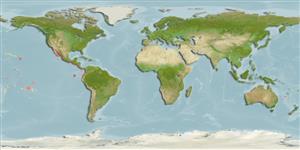Classification / Names
आम नाम | उपशब्द | Catalog of Fishes(वर्ग, प्रजाति) | ITIS | CoL | WoRMS | Cloffa
Environment: milieu / climate zone / depth range / distribution range
पारिस्थितिकी
समुद्री ड़िमरसल; गहराई सीमा 15 - 22 m (Ref. 46206). Tropical
Eastern Pacific Ocean from Nicaragua to Ecuador.
आकार / वज़न / Age
Maturity: Lm ? range ? - ? cm
Max length : 7.6 cm SL पुल्लिंग / अलिंग; (Ref. 13293)
Dactyloscopus fimbriatus is distinguished from Dactyloscopus elongatus
by several features: including number of upper lip fimbriae 15-19, mean = 17.4 (vs. 13-17, mean = 15.0); number of segmented anal-fin rays 36-39, modally 37 (vs. 38-41, modally 39); number of preopercular canal pores mean = 14.8 (vs. 8.6); some body proportions; coloration with distinct markings (vs. weak to absent) (Ref. 82814).
Life cycle and mating behavior
परिपक्व अवधि | पुनरुत्पत्ति | मछलीऔ का अंडे देना | अंडे | Fecundity | लार्वा
Nelson, J.S., E.J. Crossman, H. Espinosa-Pérez, L.T. Findley, C.R. Gilbert, R.N. Lea and J.D. Williams, 2004. Common and scientific names of fishes from the United States, Canada, and Mexico. American Fisheries Society, Special Publication 29, Bethesda, Maryland. ix, 386 p. + 1 CD. (Ref. 52299)
IUCN Red List Status (Ref. 130435: Version 2024-1)
Threat to humans
Harmless
Human uses
साधन
Special reports
Download XML
इंटरनेट स्रोत
Estimates based on models
Preferred temperature (Ref.
123201): 25.9 - 29.1, mean 28.3 °C (based on 85 cells).
Phylogenetic diversity index (Ref.
82804): PD
50 = 0.5000 [Uniqueness, from 0.5 = low to 2.0 = high].
Bayesian length-weight: a=0.00389 (0.00180 - 0.00842), b=3.12 (2.94 - 3.30), in cm total length, based on all LWR estimates for this body shape (Ref.
93245).
Trophic level (Ref.
69278): 4.4 ±0.7 se; based on size and trophs of closest relatives
Fishing Vulnerability (Ref.
59153): Low vulnerability (10 of 100).
